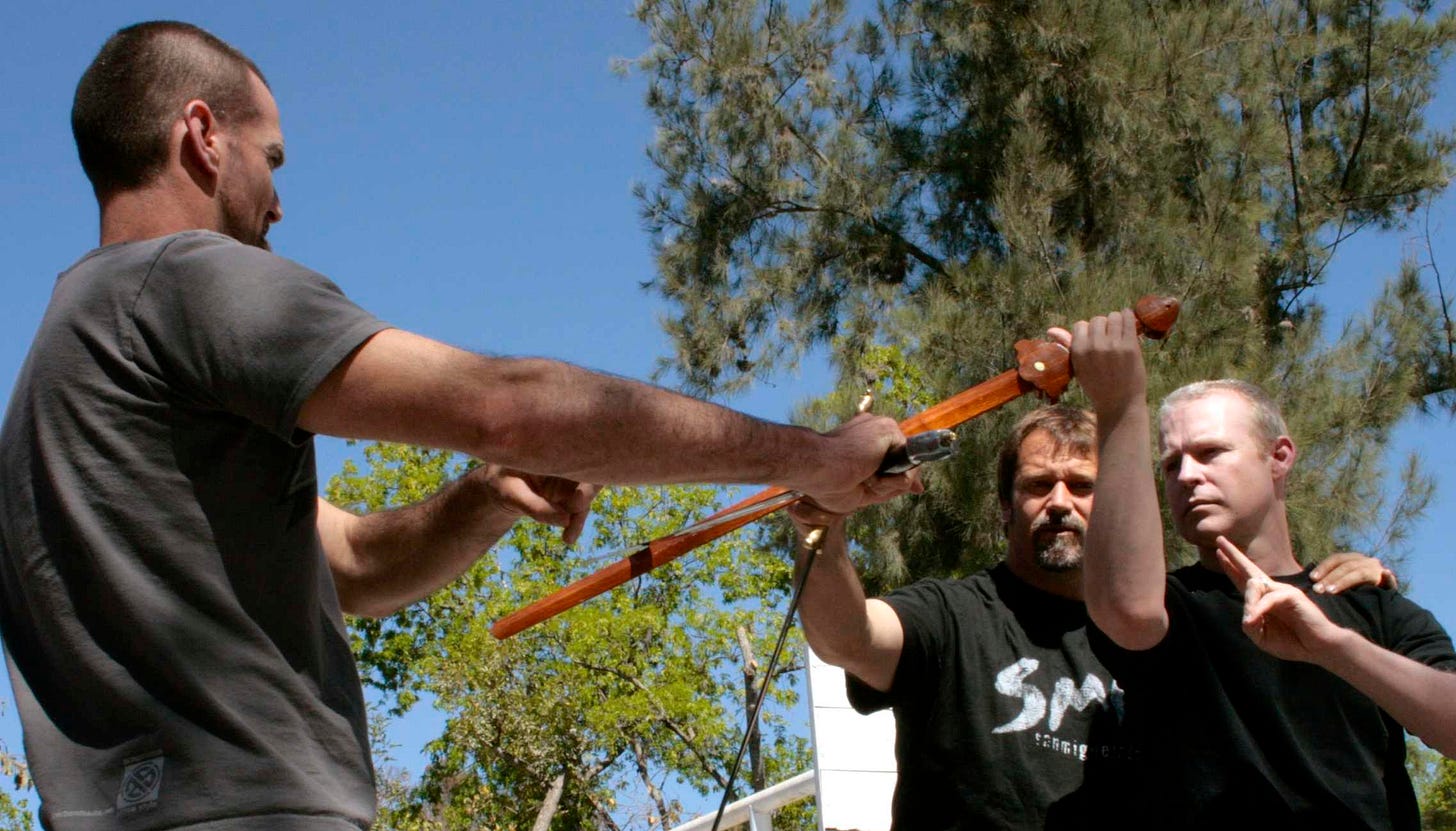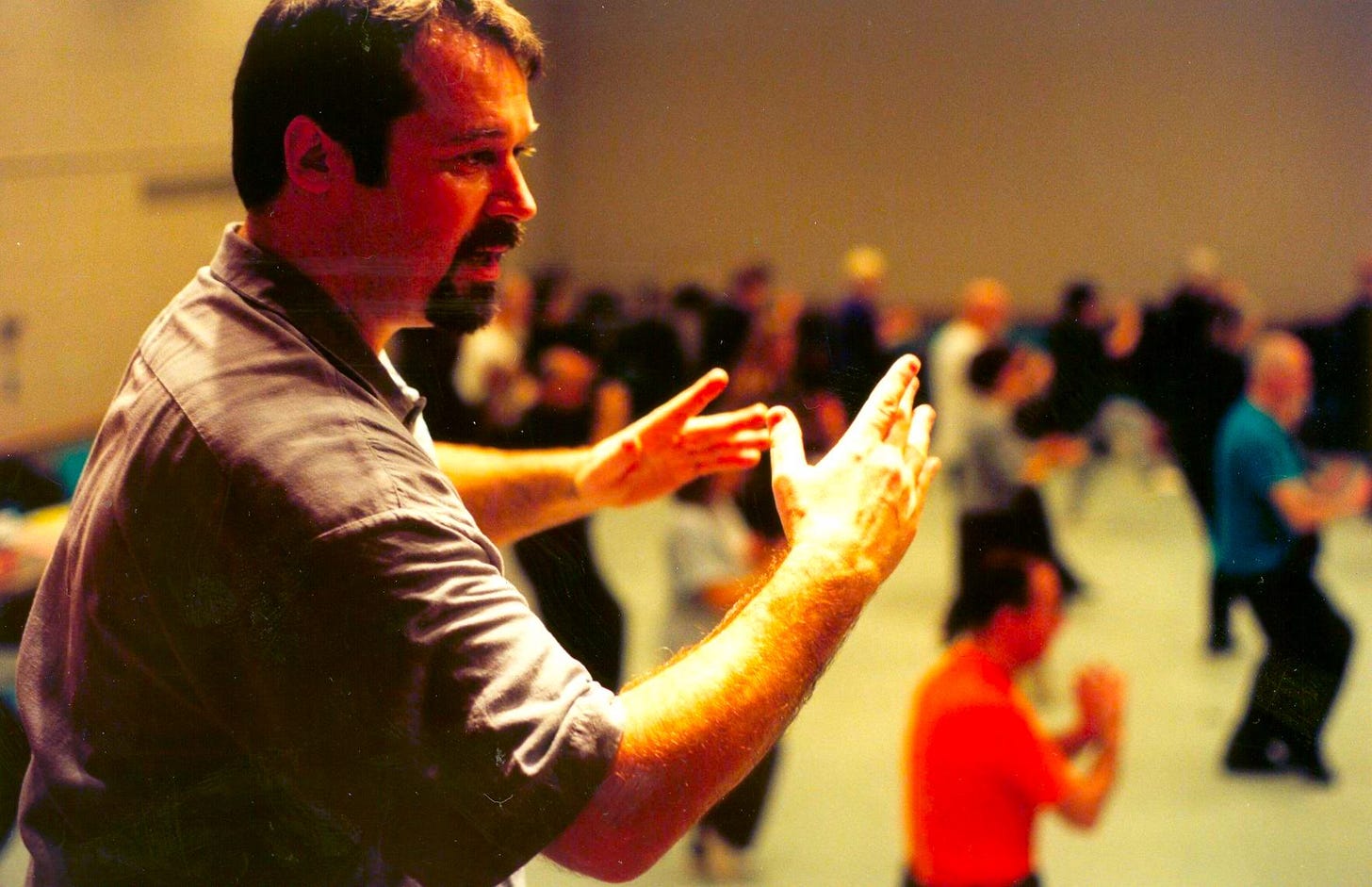This piece shares observations and advice from my years of teaching and aims to address some of the issues taijiquan instructors face when offering their programs. It is broken into three parts: 1. Teaching tips, 2. Questions from instructors. 3. Masich Internal Arts Method Instructor Students.
1. Teaching tips
What does it take to be an excellent taijiquan instructor? How can you make it possible for your students to share a long and intense learning journey with you?
Here are a few tips:
Love sharing it
More than any other personal characteristic or set of skills, your passion for sharing taijiquan with others will contribute the most to your success as a teacher. For many instructors, the desire to teach comes naturally. No matter your level, if you can make sharing your understanding part of your own taijiquan learning process, you and others will benefit. Your enthusiasm is usually the single most powerful force in the classroom.
Be good at it
Clarity with the material and its presentation is a big reason why students stay with a teacher. Observant students see the connection between the quality of they are taught and how they are progressing. Continually improve your understanding by study, practice, and research of all aspects of taijiquan. Your ongoing efforts to progress in the art will inspire students to do the same.
Connect
Good taijiquan instructors make a personal connection with their students. Know your students’ names and what their interests are, especially with regard to their taijiquan and internal arts journey. Teacher-student connection is both social and physical and requires time, communication, good will, and clear intention. Establishing trust by taking a real interest in a student’s progress and questions is an important key to instructor excellence. Taijiquan, with its strong emphasis on partner work, is an excellent vehicle for making a physical connection. The helpful and respectful way you touch, touches people.
Encourage
There is always something to praise in a student’s efforts. In situations where there is much correction to be done, making positive and encouraging comments lets students know in which direction they should be going. Take time to explain things until they are understood as well as can be for that session. Acknowledge the work your students are doing in trying to understand even if they are not there yet. A good taijiquan program is made up of attainable components and can be broken into parts small enough for anyone to experience success and progress with.
Keep your word
Make an utmost effert in every teaching situation to follow through on tasks begun or promised. Consistency breeds good will and creates a foundation for long term teacher-student relationships based on trust. The forms and exercises of taijiquan include thousands of small skills that require much time and perseverance. Encourage your students to keep track of what they’ve learned by developing an excellent sense of what you have taught. Consider what needs to happen in your program over the next several months or more and keep on track with what’s coming next.
Have fun
If it’s not fun there is no reason to expect that students will stay. An attitude of playful curiosity encourages the kind of relaxation needed to make progress in taijiquan. Laughter loosens the diaphragm, deepens breathing and relieves stress. Students are generally more likely to succeed with difficult tasks when you are not making things too serious. You do not have to be teaching every minute of the class. Let students have time to enjoy one another.
Be yourself
First and foremost, taijiquan practice is for learning about and improving yourself. It is important not to become lost to this in the course of teaching. It takes time to develop a teaching style that matches your personality and temperament. Fortunately, there are many ways to encourage students along the taijiquan path. It is important find authentic ways to share, connect, inspire, and have fun. Developing yourself starts with being yourself.
Share these practice tips
Here is a link to a description of four important practice tips to share with students incuding: Three ways of practice, Practice Rituals, the MIAM Practice Log, and Valuing your training partners.
Set goals
It can motivate a student or a group to have tangible goals to accomplish. These can be personal, for example, encouraging students to set goals for their home practice. Goals can be set for the entire group: preparing for a school demo, entering a competition, or achieving a target number of repetitions by a certain date. Getting students to set personal and group targets can be highly motivating for you as a teacher as well.
2. Questions from instructors
How much time should be devoted to teaching taiji core-principles and concepts compared to that spent teaching elements of curriculum?
There is no single approach to teaching forms and core-principles that will satisfy every situation. An instructor must be sensitive to the needs, the moods, and the capabilities of the students.
Generally speaking, students need to have something they can apply the principles to. Learning and completing forms can, itself, be fun and bring about a sense of accomplishment. Deeper analysis will come later. It may not make sense to focus extensively on core-principles studies in the very early stages of training before the student (who is already filled with new concepts and ideas) feels they have something to work with.
Of course, it is fine to make students aware that there is something more going on than just the forms and to gradually introduce core-principles as part of the form-teaching process. As students progress, core-principles and connection skills should increasingly become the focus.
How do I keep from becoming bored with teaching the same material over and over?
This is a difficult problem for almost any teacher of any subject. There are always new students starting from the beginning; there are students who take a long time to learn the lessons; and there is the need to offer a consistent program to the community. Taijiquan instructors, therefore, spend a lot of time teaching the same material over and over. Fortunately, individuals learn things in different ways. For the observant instructor, finding novel ways of dealing with the curious questions asked by learners can make the process of teaching stimulating—even in repetition. How can you teach the same lesson differently for this particular person or in this new situation? Can you be consistent without ever repeating yourself?
To a certain extent one must simply accept the situation. Mastery of anything worthwhile requires much repetition anyways, so, for those instructors intending to master their art, the problem of repetition can be approached with a degree of appreciation—‘paid practice’ some instructors call it (assuming one is getting paid!).
As your groups develop and players become more advanced, there is the possibility not only of of introducing new material, but also of looking at familiar material in new ways in light of the students’ progress. Many skills in taijiquan are ‘simple but not easy;’ repetition and humility often go hand-in-hand as the more advanced rediscover the basics on their thousandth effort as if for the first time.
Finally, it is possible to work on forms, core-principles, connection skills, etc., at different levels simultaneously. There is the level that the skill is being taught at for the benefit of the students and then there is the secret study that the teacher is undertaking internally in the background. How could that be boring?
There are so many types of student in my classes. How should I organize things?
One of the great challenges for taijiquan instructors has to do with the diversity of participants in a program. Your class may have eighteen year olds learning alongside eighty-year olds. Some are there for health, reasons, some for martial arts, some for recreational-social activity, and others to enhance a program of self-cultivation. It often occurs that a large group of students appears when a new session is begun but thins out by the end of that session leaving you with a class comprised of students who have all started at different times.
As instructors improve their ability with ‘contingency planning,’ any and all of these issues can be dealt with. One may intend that a program will run in a certain way but in reality it will depend on the configuration of individuals present at that given time. Other contingencies such as venue availability, scheduling, cost, time of year, etc, all play into planning. Taijiquan has material to benefit everyone and it is up to the instructor to decide which curriculum modules suit the class.
Observe how students naturally group themselves within a class based on shared skill level, age, familiarity with one another, gender, and other factors. Aside from the issue of skill level, none of these other considerations should dominate class grouping dynamics. Take care not to allow cliques to form that make some participants feel excluded. Encourage students to practice together in different configurations. Importantly, do not neglect the needs of either the less or the more advanced students for the sake of the largest demographic in the class.
If your class has within it multiple levels, each working on different material, find occasions for common work to bind the group as a whole. For example, start and end class with a warm-up or cool-down such as the ‘Small Power Loop,’ light stretching, or a game. Every so often, bring the group together to learn or review a core-principles concept. It is possible for a class be diverse and yet meet everyone’s needs. It is your responsibility to know where everyone is at in their learning process and to keep everyone moving along in a satisfactory way—one must learn the art of student-juggling!
The problem of different sub-groups of students in the same class is not easy to solve. With extremely different skill levels it is possible to offer dedicated beginner, intermediate, and advances classes but the problem will still persist in each class. One must accept varying degrees of contingency planning which means being vigilant, even from class to class.
Should I only teach taijiquan material in a class or can I mix it with material from other martial arts, qigong, or meditative practices?
It is possible to organize your class in any way you like, however, taijiquan and other disciplines are not always compatible with one another and it may be that mixing material leads to a cross-purposed outcome. As well, adding other non-taijiquan material increases the variables for course planning and, for this reason, can present logistical problems for your program. Again, this is a question of contingency planning.
If you and your students are prepared to work through the challenges of a mixed program it may be possible to work with distinct bodies of material along parallel tracks with some crossover. Overall, however, the logistical headaches and confusion created for your students may outweigh the benefits. It might be better in to offer different material in separate sessions.
3. Masich Internal Arts Method Instructor Student (Also known as a ‘Senior Student’)
In the Masich Internal Arts study environment an 'Instructor Student' is a Registered Student that wishes to teach curriculum from The Masich Internal Arts Method and has requested in person or in writing to become an Instructor Student. If accepted, an evaluation will take place to consider which material is appropriate for the applicant to teach and he or she will be publicly acknowledged and supported as an Instructor of The Masich Internal Arts Method. Here are some of the Masich Internal Arts Affiliated Schools & Instructors.
Here you can learn more about the 'Instructor Student Program.'













Great article. As a teacher is always nice to remember what's important.
What’s more, you do practice what you preach in your classes